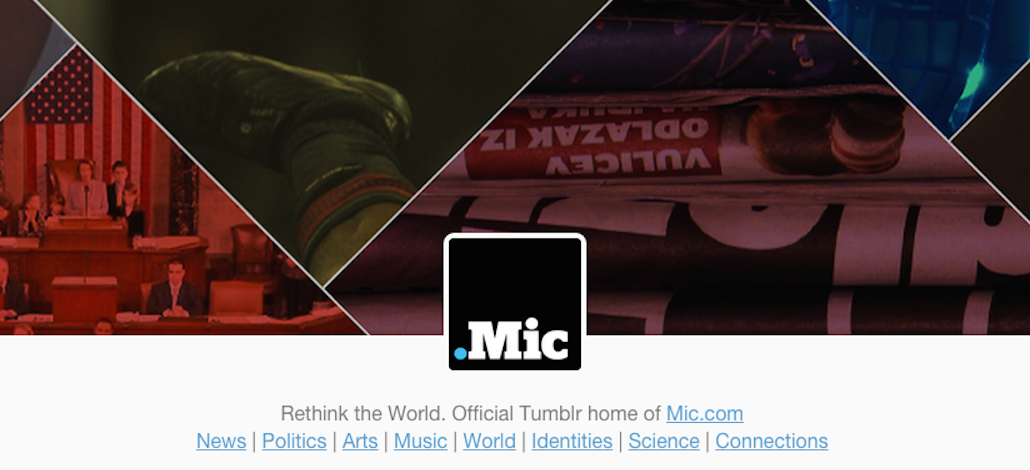
A little more than a year ago, Mic (then still known as PolicyMic) had just a few hundred followers on Tumblr and was doing nothing but reblogging posts from other accounts. Today, Mic’s Tumblr has nearly 100,000 followers and the referrals it generates constitute 5 percent of Mic’s total monthly traffic.
For comparison, when Shareaholic conducted its latest social media trends report, it found that Tumblr accounted for less than 1 percent of referrals to publishers. (Facebook was No. 1, accounting for 24.6 percent of traffic, followed by Pinterest with more than 5 percent.)
Publishers have been able to scale readerships at unprecedented rates over the past several years by gaming social networks, namely Facebook. Now, so-called viral publishers, such as USA Today’s sports blog For The Win, are looking to diversify their mix of traffic referrers as a hedge should Facebook ever throttle distribution for publishers. Mic’s success on Tumblr provides an interesting lesson for publishers looking to similarly Facebook-proof their sites.
Much of the credit belongs to Alex Rabinowitz, Mic’s programming editor — the equivalent of an “audience development” or “social media” editor — who overhauled Mic’s Tumblr strategy when he joined last January.
Identifying an opportunity
Rabinowitz recognized Tumblr as an untapped resource largely because of his personal success on the platform. He started the Tumblr Pop Culture Brain in 2008 while in college, and Tumblr soon highlighted it to users as a follow-worthy blog. Pop Culture Brain now boasts 345,000 followers, Rabinowitz said.
What he learned in scaling his personal Tumblr was the value in catering to the site’s niches.
“Tumblr is notorious for being an insular space. It’s been really hard to crack for a lot of news organizations. But I thought it was a perfect fit because the people there are the exact audience Mic is trying to reach and represent: Young, passionate about social issues such as race, LGBT issues, feminism,” he told Digiday. “And Mic was already writing all this stuff about that.”
Speaking Tumblr’s language
Rabinowitz’s predecessor did little on Tumblr other than reblog other Tumblr posts. “It wasn’t a focused strategy,” Rabinowitz said.
Armed with his knowledge of what fared well on Tumblr, Rabinowitz began posting Mic stories in Tumblr’s distinct, visual style. He turned the photos from a Mic listicle about Michelle Obama into a series of memes. He employed a similar tack for a story about reddit users creating two-sentence horror stories.
The posts were shared widely on Tumblr — each received more than 250,000 “notes” (likes and reblogs) — and their popularity provided Mic with a “base” of a few thousand followers, Rabinowitz said.
Growth hacking
In order to fuel greater growth, Rabinowitz decided to start interacting with Tumblr users who expressed interest in, but did not follow, Mic. If a user liked or reblogged a Mic post but was not following Mic’s Tumblr, Rabinowitz would have Mic’s Tumblr start following and engaging (liking, reblogging) with that user’s Tumblr. The idea was that the interactions would familiarize users with Mic’s Tumblr, thus inducing them to start following the account.
It worked, and now Tumblr drives approximately 1 million referrals to Mic’s website per month, Rabinowitz said. That’s more than Twitter, which sends only 500,000 referrals per month. Social is the largest referral category for Mic, and Facebook accounts for the majority of those referrals.
Post early, post often
One distinct characteristic of Tumblr is that it’s difficult to overwhelm its users with posts. While Mic posts about 70 percent of its stories to Facebook, it posts all of its stories to Tumblr.
“There’s no algorithm, so it’s not going to hurt you objectively to post more,” Rabinowitz said. “Posting more is never going to hurt you as long as the posts are spaced out enough.”
Advice to other publications
Tumblr’s unique user base has made it inscrutable to many publishers, as Rabinowitz noted. But publishers might see a sizable return if they’re able to find and resonate with an audience on the platform.
“I talk about Tumblr like it’s this big monolith, but it’s actually a bunch of small communities with specific interests. You can find your niche on Tumblr and engage with them,” he said. “There is a lot of room there, but you have to listen to what works with the Tumblr community.”
Homepage image courtesy Mic’s Tumblr
More in Media

From sidelines to spotlight: Esports events are putting creators center stage
Esports events’ embrace of content creators reflects advertisers’ changing priorities across both gaming and the wider culture. In the past, marketers viewed esports as one of the best ways to reach gamers. In 2025, brands are instead prioritizing creators in their outreach to audiences across demographics and interest areas, including gaming.

Condé Nast and Hearst strike Amazon AI licensing deals for Rufus
Condé Nast and Hearst have joined the New York Times in signing a licensing deal with Amazon for its AI-powered shopping assistant Rufus.

Media Briefing: AI payouts may be entering a new era
AI compensation is evolving — and new models, not just publisher demands, are driving the shift beyond flat-fee licensing.





